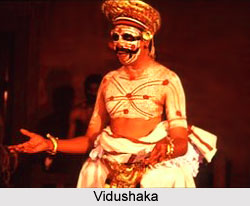 Vidushaka or the Joker, as it is also known as, is used as comic interludes in the Ramlila of Bhimtal. All of them improvised and most probably reflecting similar, unrecorded, improvisations in the production of classical Sanskrit plays are not restricted to the Joker scenes. Thus the public presentation of the various royal competitors for Sita`s favour has traditionally been a welcome occasion for comic improvisation. In the Bhimtal Ramlila, for example, one of the rajas is presented as a contemporary victim of urbanization: he enters staggering, in bell-bottom pant, a bottle in his hand, has been married 16 to 17 times, and is introduced and addressed as Mr. up-to-date/but you are late-obviously, he is to impersonate our Kaliyuga, the present age of degeneracy, in sharp contrast to Lord Rama, the ideal ruler and husband, exponent of a past age of perfection.
Vidushaka or the Joker, as it is also known as, is used as comic interludes in the Ramlila of Bhimtal. All of them improvised and most probably reflecting similar, unrecorded, improvisations in the production of classical Sanskrit plays are not restricted to the Joker scenes. Thus the public presentation of the various royal competitors for Sita`s favour has traditionally been a welcome occasion for comic improvisation. In the Bhimtal Ramlila, for example, one of the rajas is presented as a contemporary victim of urbanization: he enters staggering, in bell-bottom pant, a bottle in his hand, has been married 16 to 17 times, and is introduced and addressed as Mr. up-to-date/but you are late-obviously, he is to impersonate our Kaliyuga, the present age of degeneracy, in sharp contrast to Lord Rama, the ideal ruler and husband, exponent of a past age of perfection.
The most popular figure on the stage is privately known as Badridatta Pande, a Brahman by caste; in the Ramlila he is the leading Joker. This dialogue is conducted in the substandard variety of Hindi called, somewhat contemptuously, `Bazaar Hindustani`; at the same time it is the kind of language that would be used in a Hindi context in order to caricature the way British sahib would handle the `vernacular`. Thus while one makes fun of the former masters and their contemporary imitations, one may still participate in their prestige.
The closest one can get in own culture to this kind of language use, including puns like the one on fauran - `right now`, and faurin - `foreign`, `abroad` - are perhaps the dialogues of Shakespearian clowns, which are remarkable for a similar language consciousness. Not surprisingly, therefore, one of the Jokers which are what they are called in the Hindi original as well in another improvised scene, is converted into a language teacher:
This article is a stub. You can enrich by adding more information to it. Send your Write Up to content@indianetzone.com



















